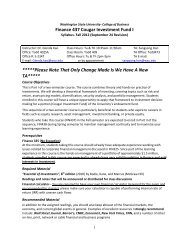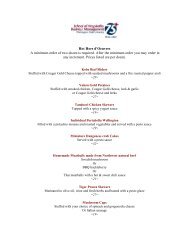Hospitality Business Management: - College of Business ...
Hospitality Business Management: - College of Business ...
Hospitality Business Management: - College of Business ...
You also want an ePaper? Increase the reach of your titles
YUMPU automatically turns print PDFs into web optimized ePapers that Google loves.
When it comes to logos,<br />
Henderson says consumers<br />
tend to like and remember<br />
those that are more<br />
concrete than abstract. For<br />
example, General Mills’<br />
Green Giant and Arm<br />
& Hammer’s bulging<br />
bicep have been hits with<br />
consumers for decades. Symbols like<br />
triangles, on the other hand, are<br />
more easily forgotten,<br />
she says.<br />
“Car logos are notoriously<br />
bad,” Henderson<br />
says. “They don’t mean<br />
anything.”<br />
She adds, “Not that we want a<br />
bunch <strong>of</strong> logos with big guys wearing<br />
leaves.” Some <strong>of</strong> the most successful<br />
logos are simple drawings <strong>of</strong><br />
recognizable objects, such<br />
as the World Wildlife Fund’s<br />
black-and-white panda<br />
symbol, Henderson says.<br />
“People love that,” she<br />
says. “It’s graphical. There’s<br />
not too much detail.”<br />
Yearning for yesterday<br />
Recent research by Department <strong>of</strong><br />
Marketing chair Darrel Muehling<br />
and CB associate pr<strong>of</strong>essor David<br />
Sprott sheds light on a popular<br />
advertising trend: the use <strong>of</strong> nostalgic<br />
themes.<br />
In their 2004 study “The Power <strong>of</strong><br />
Reflection: An Empirical Examination<br />
<strong>of</strong> Nostalgia Advertising Effects,”<br />
the duo commented that it’s no<br />
coincidence that advertisers are<br />
reminding consumers to return to<br />
their pasts during a time when people<br />
are “uncertain and anxious about<br />
the future.” They note that many <strong>of</strong><br />
today’s ads feature the styles, scenes,<br />
and characters—including Mr. T and<br />
ALF—popular in the 1960s, 1970s,<br />
and 1980s.<br />
Muehling says it’s not so important<br />
who the characters are, just that they<br />
conjure memories <strong>of</strong> a time gone by.<br />
“ALF may not be what you were<br />
thinking about” when consumers<br />
watch the ad, he says. “You might<br />
be thinking about how old you were<br />
when ALF was popular…ALF puts you<br />
back to a certain time.”<br />
As part <strong>of</strong> the 2004<br />
study, Muehling and Sprott<br />
presented research subjects<br />
with two fictitious print<br />
advertisements for Kodak<br />
film. Both ads showed a<br />
photo <strong>of</strong> a group <strong>of</strong> boys<br />
wearing football jerseys<br />
smiling at the camera in a back yard.<br />
The nostalgic version <strong>of</strong> the ad reads,<br />
“Re-Live the Moment. Last Day <strong>of</strong><br />
Summer. August 28, 1985.” The<br />
other ad reads “Capture the Moment.<br />
August 28, 2001.”<br />
The nostalgic ad roused more<br />
memory-related comments from the<br />
subjects. They wrote “reminds me <strong>of</strong><br />
being a kid,” “brings back memories<br />
to the last day <strong>of</strong> summer,” and<br />
“go<strong>of</strong>ing around was so much fun.”<br />
The study found that the nostalgiathemed<br />
advertisements stir more<br />
favorable consumer attitudes toward<br />
both the ads and the brands over ads<br />
that don’t remind consumers <strong>of</strong> the<br />
past. Gender and age had no influence<br />
on those findings.<br />
So why wouldn’t every company<br />
use nostalgia in their advertising? For<br />
one, nostalgia themes are just one<br />
<strong>of</strong> hundreds <strong>of</strong> ad executions from<br />
which to choose, Muehling says.<br />
Additionally, nostalgic ads rouse<br />
negative thoughts as well as positive<br />
ones. They portray yesteryear<br />
through rose-colored glasses, and<br />
“consumers may strongly desire to<br />
return to their pasts, but realize that<br />
this cannot occur,” the study says.<br />
Through further research, Muehling<br />
hopes to learn why nostalgic advertising<br />
works more effectively on some<br />
people than others and to determine<br />
whether it’s more appropriate for<br />
some products versus others.<br />
Reaching skeptical<br />
consumers<br />
Some <strong>of</strong> the hardest consumers to<br />
reach are those who distrust advertising<br />
claims. CB dean and marketing<br />
pr<strong>of</strong>essor Eric Spangenberg,<br />
along with Seattle University’s Carl<br />
Obermiller and the University <strong>of</strong><br />
Washington’s Douglas MacLachlan,<br />
found skeptical consumers are<br />
more responsive to ads that strike<br />
an emotional chord rather than<br />
ads riddled with product<br />
information.<br />
Their study, “Ad Skepticism:<br />
The Consequences <strong>of</strong><br />
Disbelief,” was published<br />
in the Journal <strong>of</strong> Advertising<br />
in 2005. Fifty-four subjects,<br />
whose skepticism levels<br />
were rated using a scale developed<br />
by Spangenberg and Obermiller in<br />
1998, were shown eight television<br />
commercials. Four commercials were<br />
considered emotional, such as an<br />
Ernest & Julio Gallo wine ad that<br />
showed a family atmosphere at a<br />
winery. The other four were informational<br />
appeals, such as an ad for Joy<br />
dishwashing liquid that described<br />
how the product removes baked-on<br />
foods.<br />
The study found that both the<br />
highly skeptical and less skeptical<br />
subjects responded better to the emotional<br />
appeals, despite the common<br />
perception that consumers think<br />
emotional ads are manipulative.<br />
“The important point about<br />
skepticism is not that it doesn’t occur<br />
or exist, but that it occurs or exists<br />
at varying levels across people,” says<br />
Spangenberg, who previously studied<br />
what types <strong>of</strong> people are more or less<br />
skeptical than others.<br />
A particular consumer’s level<br />
<strong>of</strong> skepticism has to do with how<br />
much experience they have with<br />
advertising, not necessarily how well<br />
educated they are. A study in the<br />
16 WSU <strong>College</strong> <strong>of</strong> <strong>Business</strong>












